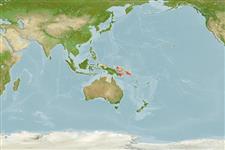Lớp phụ Cá sụn (cá mập và cá đuối) (sharks and rays) >
Orectolobiformes (Carpet sharks) >
Hemiscylliidae (Bamboo sharks)
Etymology: Hemiscyllium: hemi-, from hemisys (Gr.), half, presumably referring to similarity and/ or close affinity to Scyllium (=Scyliorhinus, now in Scyliorhinidae) and/or Chiloscyllium; skylion, Greek for dogfish or small shark. (See ETYFish); michaeli: In honor of photographer and aquarist Scott W. Michael, who brought the difference between this species and H. freycineti to the authors’ attention, and for contributing information and photographs to the senior author’s research on Indo-Pacific fishes. (See ETYFish).
Environment: milieu / climate zone / depth range / distribution range
Sinh thái học
Biển Sống nổi và đáy; Mức độ sâu 2 - 20 m (Ref. 90102). Tropical
Westen Pacific Ocean: Eastern Papua New Guinea.
Bộ gần gũi / Khối lượng (Trọng lượng) / Age
Maturity: Lm ? range ? - ? cm
Max length : 69.5 cm TL con đực/không giới tính; (Ref. 83755); 25.7 cm TL (female)
Short description
Hình thái học | Sinh trắc học
The species was previously confused with H. freycineti, which is restricted to Papua Barat Province (western New Guinea), Indonesia. The two species differ primarily in colour pattern, which provides the best means of separating the various members of the genus. Both species have a profuse covering of brown spots with a large black or brown ocellated marking on the middle of the side, just behind the head. The spots of H. michaeli are generally denser, larger, and distinctly polygonal, remarkably similar to the spots of a leopard. In contrast those of H. freycineti are round to transversely elongate and are darkened at regular intervals to form 8-9 bars or saddle-like markings (including those on the tail). The difference in spot pattern between the two species is particularly evident in the head region. In addition, H. michaeli possesses a vivid ocellate black spot behind the head, whereas the black spot of H. freycineti is generally not well defined. Comparison of the mitochondrial ND4 gene also supports the species-level separation of these species.
Usually encountered on coastal fringing reefs and patch reefs during night diving, although it is sometimes seen during the day, sheltering under rocky outcrops or tabular corals (Ref. 83755).
Life cycle and mating behavior
Chín muồi sinh dục | Sự tái sinh sản | Đẻ trứng | Các trứng | Sự sinh sản | Ấu trùng
Allen, G.R. and C.L. Dudgeon, 2010. Hemiscyllium michaeli, a new species of Bamboo Shark (Hemiscyllidae) from Papua New Guinea. aqua, Int. J. Ichthyol. 16(1):19-30. (Ref. 83755)
IUCN Red List Status (Ref. 130435)
Threat to humans
Harmless
Human uses
Thêm thông tin
Age/SizeSự sinh trưởngLength-weightLength-lengthLength-frequenciesSinh trắc họcHình thái họcẤu trùngSự biến động ấu trùngBổ xungSự phong phúBRUVS
Các tài liệu tham khảoNuôi trồng thủy sảnTổng quan nuôi trồng thủy sảnCác giốngDi truyềnElectrophoresesDi sảnCác bệnhChế biếnNutrientsMass conversion
Các công cụ
Special reports
Download XML
Các nguồn internet
Estimates based on models
Phylogenetic diversity index (Ref.
82804): PD
50 = 0.5020 [Uniqueness, from 0.5 = low to 2.0 = high].
Bayesian length-weight: a=0.00407 (0.00181 - 0.00918), b=3.09 (2.89 - 3.29), in cm total length, based on LWR estimates for this (Sub)family-body shape (Ref.
93245).
Mức dinh dưỡng (Ref.
69278): 3.4 ±0.3 se; based on size and trophs of closest relatives
Fishing Vulnerability (Ref.
59153): Moderate to high vulnerability (48 of 100).
